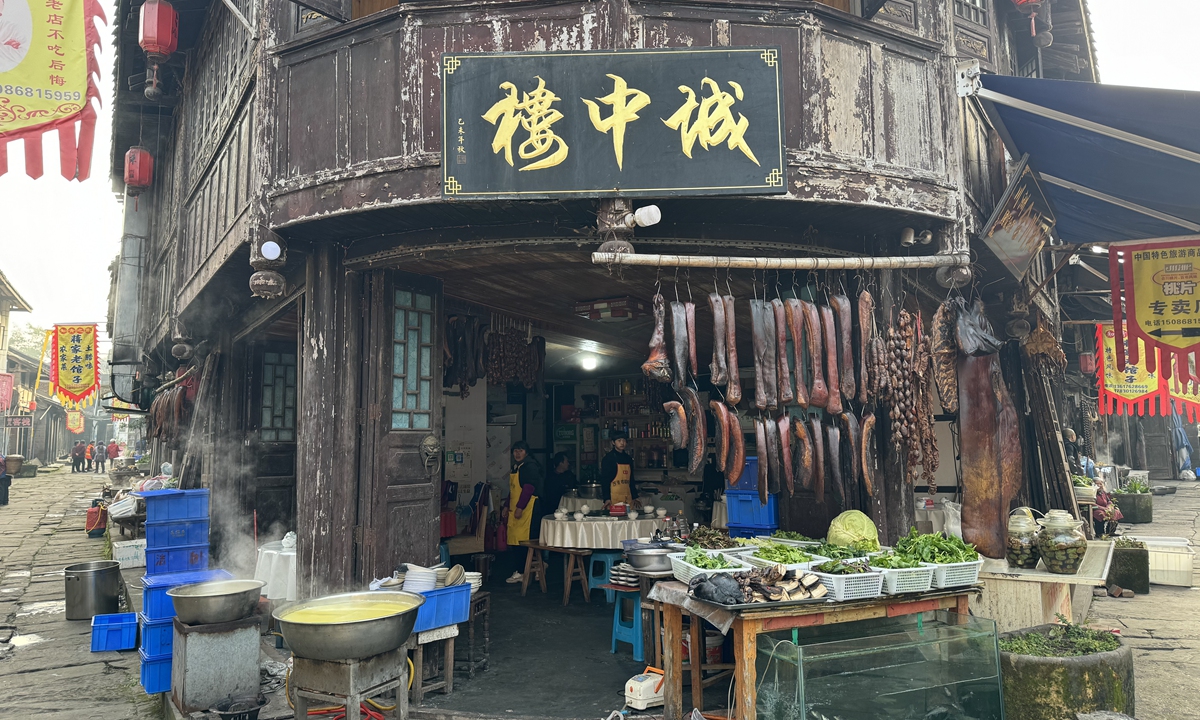
Cured pork belly and fresh vegetables are displayed outside a resturant in Chongqing's Laitan Ancient Town. Photo: Li Yuche/GT
"Middle-hill bus," a capsule-shaped vehicle with only 10 seats, is obviously not practical to be a public transport vehicle, especially in Chongqing Municipality, a megacity in Southwest China with more than 20 million people living in its main urban districts.
Far from the traditional commute, the mini vehicle solely offers a city tour to travelers, ferrying them to cultural, historical and tourist hot spots, starting from the shuttling sky train at the Liziba station to Testbed 2, an artsy cultural block created from a repurposed industrial factory.
Known as a mountain city, Chongqing's touristic spots are largely scattered along a way up the hill top with its ridiculously narrow alleys. The "impractical middle-hill bus" is therefore the only practical form of transportation and epitomizes the city's updated tourism industry in catering to a growing number of touristic interests in recent years since the bus tour was launched merely two years ago.
Industrial chicThe city hosted more than 10 million tourists during the just-concluded eight-day Spring Festival holidays.
Aside from popular scenic spots such as the Northern Song Dynasty (960-1127) Ciqikou Ancient Town and the 11-story stilt-building complex Hong Ya Dong (lit: Hongya cave), factory-based cultural venues like the Testbed 2 have surprisingly garnered much interest from visitors. Yao Siying, a 25-year-old tourist from Shanghai, told the Global Times that he believes the "revamped working-class aesthetics" shows Chongqing's "unique charm."
Testbed 2, a cultural-commercial area that encompasses an art center, cafés, vintage shops and restaurants was once a banknote printing factory dating back to the Republic of China period (1912-49). By combining the old factory's grungy aesthetic with popular business formats, the site that is rated at 4.8 out of 5 on rating and review platform Dazhongdianping, is now a "must-visit" in Chongqing since it was opened in 2017.
"What I liked about the area the most is it reflects the open-minded creativity of local planners. Also, it's a high point to see the city's night scenes," a tourist surnamed Xue from Shenzhen, Guangdong Province, told the Global Times.
The success of Testbed 2 was like an epiphany to the city to seriously consider turning its abundant industrial remains into novel tourist sites. Other than the Testbed 2 in Yuzhong district, the city boasts a total of 19 major industrial remains which are now turned touristic sites including the mysterious "816 Town" project.
The "816 Town," a cultural creative block located near to the 816 Nuclear Military Plant in the city's suburban Fuling district, is the most intriguing one since it carried the history of the unfinished Chinese nuclear weapons production project started in 1960s.
During the Spring Festival holidays, there were exhibitions and performances launched at the site depicting Chinese pioneers' dedication to the country's Third Front Construction campaign.
Eye-catching industrial renovations as such are now part of Chongqing's policy-making to boost its cultural tourism since Li Chuanbo, the founder of the 816 Town, told the Global Times that the local authority has helped greatly with regard to aspects such as "funding, security management, and publicizing."
"Repurposing such industrial resource in Chongqing is not just a strategy to boost tourism, but also a modern approach to achieve the city's sustainable urban development," Li Zhong, a local planner, told the Global Times.
The city's cultural touristic sites and the revolutionary scenic spots like the Zhazidong Prison are predominantly distributed in Chongqing's nine dominant districts.
New traveling trendThese areas were thronged by visitors from other cities or provinces during the Spring Festival holidays, which set a new trend - outside tourists come in to see the urban landscape while the locals go out for discovering joy in rural spaces.
In Bishan district, one of the closest suburban areas to the main city of Chongqing, has a folklore museum called the Chongqing Dayuanxiang Museum. The museum, although remote, is actually a treasure trove of stone and wooden sculptures dating back to the Song (960-1279) to Qing (1644-1911) dynasties.
The site has become an ideal destination for many local residents like the Wang family that lives in Yuzhong district, one of the oldest and the most important districts of the city.
"We know the main city quite well and never realized that the real Shu culture is hidden in such rural places," the mother of the family told the Global Times.
The rural area of Chongqing's Hechuan district is another notable site, which boasts the Hechuan fishing city, a former architectural complex for military defense in ancient times, but is now a new cultural-commercial complex that offers visitors the folk exhibition and authentic Chongqing cuisine such as spicy tofu pudding rice.
Known for its spicy dishes, Chongqing is a magical city that is neither its modern urban landscape nor can its rural folk stories fully reveal its true essence.